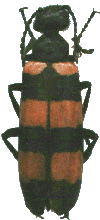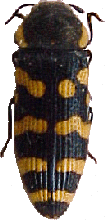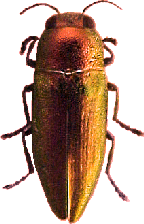MIMICRY
When a zoological species imitates another species of animal, we can
observe a case of mimicry. It occurs in many zoological groups, Vertebrates,
especially fishes, and Invertebrates. The top is reached among Insects,
and especially in species living in tropical and rain forest, where these
interspecific relations (mimicry, cryptism, symbiosis, parasitism) are
extremely common.
Typically, there are two kinds of mimicry:
1 - An inoffensive and edible species imitates a dangerous, poisonous
or disgusting species, usually not attacked by predators, wich recognize
(sometimes after some bad experiences) their colours, shapes, etc.. This
kind of mimicry was studied by H.W. Bates, and it's named "Batesian
mimicry". It is particularly useful to insects against birds, amphybians
and reptiles. To be effective, models must be more abundant than imitating
species. In other case, predators will realize the trick!
2 - Some dangerous, poisonous or disgusting species imitate one
to another, reaching the same colours, shapes, etc.. In this case, called
"Müllerian mimicry", the effect of warning signals of one species
is strengthened by signals of all the others living in the same places.
Also this system is particularly effective against the same vertebrates.
Usually, differentiating the first and second form of mimicry is not
easy. They are mostly present together, and there is a gradient from inoffensive
to dangerous species, and from edible to disgusting or poisonous species
(it must be born in mind that some animals can eat species that can be
poisonous or disgusting for others).
They are very common among Insects. Models are mostly chosen among Hymenoptera
and several Coleptera, especially species containing poisonous substances
(Meloidae, etc.).
Meloidae are the most imitated models by Buprestidae. The group of Mylabrini
show a typical red/orange and black pattern. The same colours is used by
many Buprestidae in the world: many Acmaeodera in Nearctic and, especially,
Palearctic Region; many Stigmoderini (Castiarina in Australia, Conognatha
and Dactylozodes in South America); several Polycestinae, etc.
Why the same colours are used in Europe, Africa, Australia, America,
etc.? Probably it was produced by migratory birds. If birds during the
Summer learn to stay away from red spotted black insects while they
are in Europe, they'll do the same in the cold season, in tropical Africa.
This behaviour could extend an effective pattern to all the world.

 Here
we can see few examples of Buprestidae using these colours, compared with
some poisonous or dangerous species. You can see also an image of
Scolia
flavifrons (Hymenoptera). Many Hymenoptera, mostly Apoidea and Vespoidea,
use a similar pattern, and are imitated by many Diptera, Lepidoptera and
Coleoptera (mostly Buprestidae and Cerambycidae: Clytus, Neoclytus,
Chlorophorus, Plagionotus, Megacyllene, etc.). Here we have
a Polystes (Hymenoptera Vespoidea) and a Megacyllene caryae (Coleoptera Cerambycidae,
Clytinae).
Here
we can see few examples of Buprestidae using these colours, compared with
some poisonous or dangerous species. You can see also an image of
Scolia
flavifrons (Hymenoptera). Many Hymenoptera, mostly Apoidea and Vespoidea,
use a similar pattern, and are imitated by many Diptera, Lepidoptera and
Coleoptera (mostly Buprestidae and Cerambycidae: Clytus, Neoclytus,
Chlorophorus, Plagionotus, Megacyllene, etc.). Here we have
a Polystes (Hymenoptera Vespoidea) and a Megacyllene caryae (Coleoptera Cerambycidae,
Clytinae).
These are Insects commonly used like models. They are toxic or, however,
dangerous for small Vertebrate:

|

|

|

|
Mylabris s.l.
from Maroc
|
Mylabris flexuosa.
from Italy
|
Mylabris s.l.
from Zimbabwe
|
Meloidae sp.
from USA (TX)
|

|

|
Trichodes sp.
from Tunisia
|
Scolia flavifrons
from Italy
|
And these are some mimic Buprestidae. They belong to Polycestinae, Acmaeoderinae,
Chrysochroinae, Buprestinae.

|

|

|

|
Conognatha sowerbi
from Chile
|
Pygicera scripta
from Chile
|
Castiarina trifasciata from Australia
|
Stigmodera martini
from Australia
|

|

|

|

|
Astraeus crassus
from Australia
|
Cyria imperialis
from Australia
|
Polyctesis ohkurai
from Thailand
|
Acmaeodera amplicollis
from USA (AZ)
|

|

|

|

|
Acmaeodera ottomana
from Kriti (Greece)
|
Acmaeodera quadrifasciata
from Italy
|
Buprestis novemmaculata
from Italy
|
Ptosima flavoguttata
from Italy
|
Another series of Buprestidae, especially in
the genus Anthaxia (mostly among Palearctic species) show a bright and
shiny colouration, with green, blue, purple, gold, copper, etc..Some European
entomologists supposed they imitate species of Hymenoptera Chrysididae,
but there is a problem: these little and beautiful Hymenoptera are always
quite rare, while the Anthaxia are usually common! We must also consider Chrysididae don't sting!
But they are very fast and quick, and are very hard to be kept by predators. Small Buprtestidae
living on flowers, like Anthaxia, are the same. So these bright colours cold mean: "very difficult to keep"
for birds, etc. |

Hedychrum nobile - Europe
|
Another group of Buprestidae using the same colours belong to the Australian
genus Melobasis, with several small/medium species:

Melobasis sp.
|

Melobasis regalis
|

Melobasis pyritosa
|

Melobasis gratiosissima
|

Melobasis innocua
|

Melobasis cuprifera
|

Melobasis propinqua
|

Melobasis ordinata
|
| |

Melobasis nitidiventris
|

Melobasis obscurella
|
|

 Here
we can see few examples of Buprestidae using these colours, compared with
some poisonous or dangerous species. You can see also an image of
Scolia
flavifrons (Hymenoptera). Many Hymenoptera, mostly Apoidea and Vespoidea,
use a similar pattern, and are imitated by many Diptera, Lepidoptera and
Coleoptera (mostly Buprestidae and Cerambycidae: Clytus, Neoclytus,
Chlorophorus, Plagionotus, Megacyllene, etc.). Here we have
a Polystes (Hymenoptera Vespoidea) and a Megacyllene caryae (Coleoptera Cerambycidae,
Clytinae).
Here
we can see few examples of Buprestidae using these colours, compared with
some poisonous or dangerous species. You can see also an image of
Scolia
flavifrons (Hymenoptera). Many Hymenoptera, mostly Apoidea and Vespoidea,
use a similar pattern, and are imitated by many Diptera, Lepidoptera and
Coleoptera (mostly Buprestidae and Cerambycidae: Clytus, Neoclytus,
Chlorophorus, Plagionotus, Megacyllene, etc.). Here we have
a Polystes (Hymenoptera Vespoidea) and a Megacyllene caryae (Coleoptera Cerambycidae,
Clytinae).




























